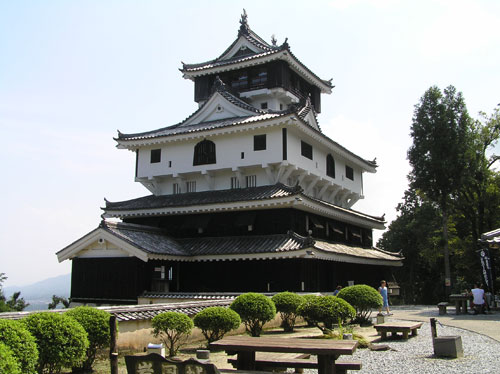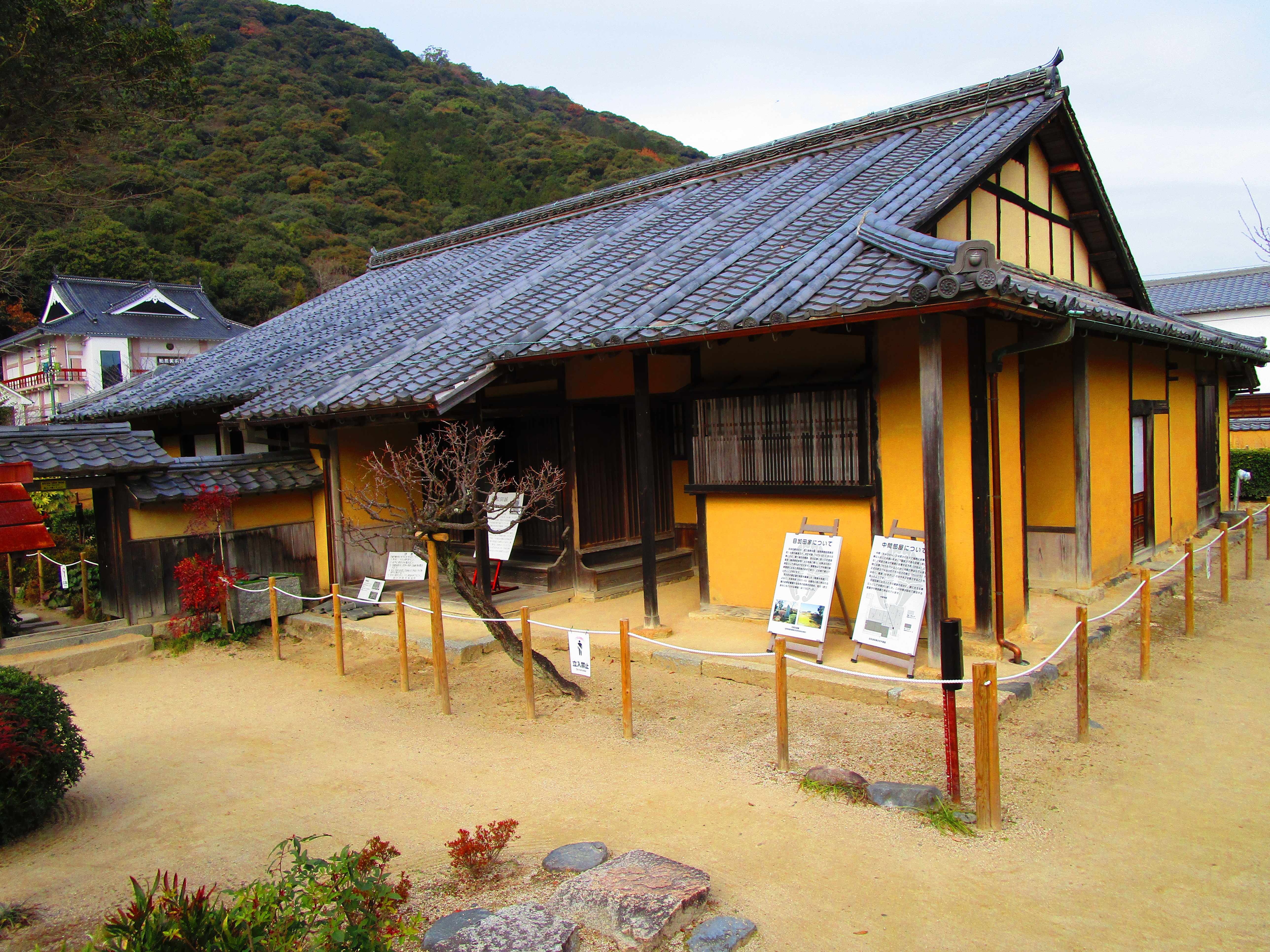Loading map...
{"format":"leaflet","minzoom":false,"maxzoom":false,"limit":500,"offset":0,"link":"all","sort":["order"],"order":[],"headers":"show","mainlabel":"","intro":"","outro":"","searchlabel":"... further results","default":"","import-annotation":false,"width":"auto","height":"350px","centre":false,"title":"","label":"","icon":"Darkred18.png","lines":[],"polygons":[],"circles":[],"rectangles":[],"copycoords":false,"static":false,"zoom":false,"defzoom":14,"layers":["Esri.WorldTopoMap"],"image layers":[],"overlays":[],"resizable":false,"fullscreen":false,"scrollwheelzoom":true,"cluster":false,"clustermaxzoom":20,"clusterzoomonclick":true,"clustermaxradius":80,"clusterspiderfy":true,"geojson":"","clicktarget":"","showtitle":false,"hidenamespace":true,"template":"InfoWindowProfile","userparam":"","activeicon":"","pagelabel":false,"ajaxcoordproperty":"","ajaxquery":"","locations":[{"text":"\u003Cdiv style=\"width:150px\"\u003E\n\u003Cp\u003E\u003Ca href=\"/view/File:Iwakuni1.jpg\" class=\"image\"\u003E\u003Cimg alt=\"Iwakuni1.jpg\" src=\"../images/thumb/0/00/Iwakuni1.jpg/125px-Iwakuni1.jpg\" decoding=\"async\" width=\"125\" height=\"94\" srcset=\"../images/thumb/0/00/Iwakuni1.jpg/188px-Iwakuni1.jpg 1.5x, ../images/thumb/0/00/Iwakuni1.jpg/250px-Iwakuni1.jpg 2x\" /\u003E\u003C/a\u003E\n\u003C/p\u003E\n\u003C/div\u003E","title":"","link":"","lat":34.17524,"lon":132.1742,"icon":"../images/0/06/Darkred18.png"},{"text":"\u003Cdiv style=\"width:150px\"\u003E\n\u003Cp\u003E\u003Ca href=\"/view/File:Iwakuni2.jpg\" class=\"image\"\u003E\u003Cimg alt=\"Iwakuni2.jpg\" src=\"../images/thumb/a/aa/Iwakuni2.jpg/125px-Iwakuni2.jpg\" decoding=\"async\" width=\"125\" height=\"167\" srcset=\"../images/thumb/a/aa/Iwakuni2.jpg/188px-Iwakuni2.jpg 1.5x, ../images/thumb/a/aa/Iwakuni2.jpg/250px-Iwakuni2.jpg 2x\" /\u003E\u003C/a\u003E\n\u003C/p\u003E\n\u003C/div\u003E","title":"","link":"","lat":34.17524,"lon":132.1742,"icon":"../images/0/06/Darkred18.png"},{"text":"\u003Cdiv style=\"width:150px\"\u003E\n\u003Cp\u003E\u003Ca href=\"/view/File:Iwakuni5.jpg\" class=\"image\"\u003E\u003Cimg alt=\"Iwakuni5.jpg\" src=\"../images/thumb/7/75/Iwakuni5.jpg/125px-Iwakuni5.jpg\" decoding=\"async\" width=\"125\" height=\"94\" srcset=\"../images/thumb/7/75/Iwakuni5.jpg/188px-Iwakuni5.jpg 1.5x, ../images/thumb/7/75/Iwakuni5.jpg/250px-Iwakuni5.jpg 2x\" /\u003E\u003C/a\u003E\n\u003C/p\u003E\n\u003C/div\u003E","title":"","link":"","lat":34.17524,"lon":132.1742,"icon":"../images/0/06/Darkred18.png"},{"text":"\u003Cdiv style=\"width:150px\"\u003E\n\u003Cp\u003E\u003Ca href=\"/view/File:Iwakuni10.jpg\" class=\"image\"\u003E\u003Cimg alt=\"Iwakuni10.jpg\" src=\"../images/thumb/3/35/Iwakuni10.jpg/125px-Iwakuni10.jpg\" decoding=\"async\" width=\"125\" height=\"94\" srcset=\"../images/thumb/3/35/Iwakuni10.jpg/188px-Iwakuni10.jpg 1.5x, ../images/thumb/3/35/Iwakuni10.jpg/250px-Iwakuni10.jpg 2x\" /\u003E\u003C/a\u003E\n\u003C/p\u003E\n\u003C/div\u003E","title":"","link":"","lat":34.16783,"lon":132.17956,"icon":"../images/0/06/Darkred18.png"},{"text":"\u003Cdiv style=\"width:150px\"\u003E\n\u003Cp\u003E\u003Ca href=\"/view/File:Iwakuni12.jpg\" class=\"image\"\u003E\u003Cimg alt=\"Iwakuni12.jpg\" src=\"../images/thumb/c/c4/Iwakuni12.jpg/125px-Iwakuni12.jpg\" decoding=\"async\" width=\"125\" height=\"94\" srcset=\"../images/thumb/c/c4/Iwakuni12.jpg/188px-Iwakuni12.jpg 1.5x, ../images/thumb/c/c4/Iwakuni12.jpg/250px-Iwakuni12.jpg 2x\" /\u003E\u003C/a\u003E\n\u003C/p\u003E\n\u003C/div\u003E","title":"","link":"","lat":34.16691,"lon":132.17901,"icon":"../images/0/06/Darkred18.png"},{"text":"\u003Cdiv style=\"width:150px\"\u003E\n\u003Cp\u003E\u003Ca href=\"/view/File:Iwakuni13.jpg\" class=\"image\"\u003E\u003Cimg alt=\"Iwakuni13.jpg\" src=\"../images/thumb/2/28/Iwakuni13.jpg/125px-Iwakuni13.jpg\" decoding=\"async\" width=\"125\" height=\"94\" srcset=\"../images/thumb/2/28/Iwakuni13.jpg/188px-Iwakuni13.jpg 1.5x, ../images/thumb/2/28/Iwakuni13.jpg/250px-Iwakuni13.jpg 2x\" /\u003E\u003C/a\u003E\n\u003C/p\u003E\n\u003C/div\u003E","title":"","link":"","lat":34.16689,"lon":132.17898,"icon":"../images/0/06/Darkred18.png"},{"text":"\u003Cdiv style=\"width:150px\"\u003E\n\u003Cp\u003E\u003Ca href=\"/view/File:Iwakuni14.jpg\" class=\"image\"\u003E\u003Cimg alt=\"Iwakuni14.jpg\" src=\"../images/thumb/b/b2/Iwakuni14.jpg/125px-Iwakuni14.jpg\" decoding=\"async\" width=\"125\" height=\"94\" srcset=\"../images/thumb/b/b2/Iwakuni14.jpg/188px-Iwakuni14.jpg 1.5x, ../images/thumb/b/b2/Iwakuni14.jpg/250px-Iwakuni14.jpg 2x\" /\u003E\u003C/a\u003E\n\u003C/p\u003E\n\u003C/div\u003E","title":"","link":"","lat":34.16689,"lon":132.17898,"icon":"../images/0/06/Darkred18.png"},{"text":"\u003Cdiv style=\"width:150px\"\u003E\n\u003Cp\u003E\u003Ca href=\"/view/File:Iwakuni15.jpg\" class=\"image\"\u003E\u003Cimg alt=\"Iwakuni15.jpg\" src=\"../images/thumb/b/b1/Iwakuni15.jpg/125px-Iwakuni15.jpg\" decoding=\"async\" width=\"125\" height=\"94\" srcset=\"../images/thumb/b/b1/Iwakuni15.jpg/188px-Iwakuni15.jpg 1.5x, ../images/thumb/b/b1/Iwakuni15.jpg/250px-Iwakuni15.jpg 2x\" /\u003E\u003C/a\u003E\n\u003C/p\u003E\n\u003C/div\u003E","title":"","link":"","lat":34.16713,"lon":132.17919,"icon":"../images/0/06/Darkred18.png"},{"text":"\u003Cdiv style=\"width:150px\"\u003E\n\u003Cp\u003E\u003Ca href=\"/view/File:Iwakuni16.jpg\" class=\"image\"\u003E\u003Cimg alt=\"Iwakuni16.jpg\" src=\"../images/thumb/9/96/Iwakuni16.jpg/125px-Iwakuni16.jpg\" decoding=\"async\" width=\"125\" height=\"94\" srcset=\"../images/thumb/9/96/Iwakuni16.jpg/188px-Iwakuni16.jpg 1.5x, ../images/thumb/9/96/Iwakuni16.jpg/250px-Iwakuni16.jpg 2x\" /\u003E\u003C/a\u003E\n\u003C/p\u003E\n\u003C/div\u003E","title":"","link":"","lat":34.16892,"lon":132.17684,"icon":"../images/0/06/Darkred18.png"},{"text":"\u003Cdiv style=\"width:150px\"\u003E\n\u003Cp\u003E\u003Ca href=\"/view/File:Iwakuni17.jpg\" class=\"image\"\u003E\u003Cimg alt=\"Iwakuni17.jpg\" src=\"../images/thumb/5/58/Iwakuni17.jpg/125px-Iwakuni17.jpg\" decoding=\"async\" width=\"125\" height=\"94\" srcset=\"../images/thumb/5/58/Iwakuni17.jpg/188px-Iwakuni17.jpg 1.5x, ../images/thumb/5/58/Iwakuni17.jpg/250px-Iwakuni17.jpg 2x\" /\u003E\u003C/a\u003E\n\u003C/p\u003E\n\u003C/div\u003E","title":"","link":"","lat":34.169,"lon":132.17669,"icon":"../images/0/06/Darkred18.png"},{"text":"\u003Cdiv style=\"width:150px\"\u003E\n\u003Cp\u003E\u003Ca href=\"/view/File:Iwakuni18.jpg\" class=\"image\"\u003E\u003Cimg alt=\"Iwakuni18.jpg\" src=\"../images/thumb/9/9e/Iwakuni18.jpg/125px-Iwakuni18.jpg\" decoding=\"async\" width=\"125\" height=\"94\" srcset=\"../images/thumb/9/9e/Iwakuni18.jpg/188px-Iwakuni18.jpg 1.5x, ../images/thumb/9/9e/Iwakuni18.jpg/250px-Iwakuni18.jpg 2x\" /\u003E\u003C/a\u003E\n\u003C/p\u003E\n\u003C/div\u003E","title":"","link":"","lat":34.16898,"lon":132.17673,"icon":"../images/0/06/Darkred18.png"},{"text":"\u003Cdiv style=\"width:150px\"\u003E\n\u003Cp\u003E\u003Ca href=\"/view/File:Iwakuni19.jpg\" class=\"image\"\u003E\u003Cimg alt=\"Iwakuni19.jpg\" src=\"../images/thumb/7/71/Iwakuni19.jpg/125px-Iwakuni19.jpg\" decoding=\"async\" width=\"125\" height=\"94\" srcset=\"../images/thumb/7/71/Iwakuni19.jpg/188px-Iwakuni19.jpg 1.5x, ../images/thumb/7/71/Iwakuni19.jpg/250px-Iwakuni19.jpg 2x\" /\u003E\u003C/a\u003E\n\u003C/p\u003E\n\u003C/div\u003E","title":"","link":"","lat":34.16722,"lon":132.17943,"icon":"../images/0/06/Darkred18.png"},{"text":"\u003Cdiv style=\"width:150px\"\u003E\n\u003Cp\u003E\u003Ca href=\"/view/File:IwakunijouART_(3).JPG\" class=\"image\"\u003E\u003Cimg alt=\"IwakunijouART (3).JPG\" src=\"../images/thumb/3/3a/IwakunijouART_%283%29.JPG/125px-IwakunijouART_%283%29.JPG\" decoding=\"async\" width=\"125\" height=\"94\" srcset=\"../images/thumb/3/3a/IwakunijouART_%283%29.JPG/188px-IwakunijouART_%283%29.JPG 1.5x, ../images/thumb/3/3a/IwakunijouART_%283%29.JPG/250px-IwakunijouART_%283%29.JPG 2x\" /\u003E\u003C/a\u003E\n\u003C/p\u003E\n\u003C/div\u003E","title":"","link":"","lat":34.17508,"lon":132.17447,"icon":"../images/0/06/Darkred18.png"},{"text":"\u003Cdiv style=\"width:150px\"\u003E\n\u003Cp\u003E\u003Ca href=\"/view/File:IwakunijouART_(6).JPG\" class=\"image\"\u003E\u003Cimg alt=\"IwakunijouART (6).JPG\" src=\"../images/thumb/f/ff/IwakunijouART_%286%29.JPG/125px-IwakunijouART_%286%29.JPG\" decoding=\"async\" width=\"125\" height=\"94\" srcset=\"../images/thumb/f/ff/IwakunijouART_%286%29.JPG/188px-IwakunijouART_%286%29.JPG 1.5x, ../images/thumb/f/ff/IwakunijouART_%286%29.JPG/250px-IwakunijouART_%286%29.JPG 2x\" /\u003E\u003C/a\u003E\n\u003C/p\u003E\n\u003C/div\u003E","title":"","link":"","lat":34.17472,"lon":132.17402,"icon":"../images/0/06/Darkred18.png"},{"text":"\u003Cdiv style=\"width:150px\"\u003E\n\u003Cp\u003E\u003Ca href=\"/view/File:IwakunijouART_(1).JPG\" class=\"image\"\u003E\u003Cimg alt=\"IwakunijouART (1).JPG\" src=\"../images/thumb/1/12/IwakunijouART_%281%29.JPG/125px-IwakunijouART_%281%29.JPG\" decoding=\"async\" width=\"125\" height=\"94\" srcset=\"../images/thumb/1/12/IwakunijouART_%281%29.JPG/188px-IwakunijouART_%281%29.JPG 1.5x, ../images/thumb/1/12/IwakunijouART_%281%29.JPG/250px-IwakunijouART_%281%29.JPG 2x\" /\u003E\u003C/a\u003E\n\u003C/p\u003E\n\u003C/div\u003E","title":"","link":"","lat":34.17457,"lon":132.17371,"icon":"../images/0/06/Darkred18.png"},{"text":"\u003Cdiv style=\"width:150px\"\u003E\n\u003Cp\u003E\u003Ca href=\"/view/File:IwakunijouART_(7).JPG\" class=\"image\"\u003E\u003Cimg alt=\"IwakunijouART (7).JPG\" src=\"../images/thumb/d/d1/IwakunijouART_%287%29.JPG/125px-IwakunijouART_%287%29.JPG\" decoding=\"async\" width=\"125\" height=\"94\" srcset=\"../images/thumb/d/d1/IwakunijouART_%287%29.JPG/188px-IwakunijouART_%287%29.JPG 1.5x, ../images/thumb/d/d1/IwakunijouART_%287%29.JPG/250px-IwakunijouART_%287%29.JPG 2x\" /\u003E\u003C/a\u003E\n\u003C/p\u003E\n\u003C/div\u003E","title":"","link":"","lat":34.17627,"lon":132.17474,"icon":"../images/0/06/Darkred18.png"},{"text":"\u003Cdiv style=\"width:150px\"\u003E\n\u003Cp\u003E\u003Ca href=\"/view/File:IwakunijouART_(5).JPG\" class=\"image\"\u003E\u003Cimg alt=\"IwakunijouART (5).JPG\" src=\"../images/thumb/6/68/IwakunijouART_%285%29.JPG/125px-IwakunijouART_%285%29.JPG\" decoding=\"async\" width=\"125\" height=\"94\" srcset=\"../images/thumb/6/68/IwakunijouART_%285%29.JPG/188px-IwakunijouART_%285%29.JPG 1.5x, ../images/thumb/6/68/IwakunijouART_%285%29.JPG/250px-IwakunijouART_%285%29.JPG 2x\" /\u003E\u003C/a\u003E\n\u003C/p\u003E\n\u003C/div\u003E","title":"","link":"","lat":34.17602,"lon":132.17442,"icon":"../images/0/06/Darkred18.png"},{"text":"\u003Cdiv style=\"width:150px\"\u003E\n\u003Cp\u003E\u003Ca href=\"/view/File:IwakunijouART_(8).JPG\" class=\"image\"\u003E\u003Cimg alt=\"IwakunijouART (8).JPG\" src=\"../images/thumb/9/9b/IwakunijouART_%288%29.JPG/125px-IwakunijouART_%288%29.JPG\" decoding=\"async\" width=\"125\" height=\"94\" srcset=\"../images/thumb/9/9b/IwakunijouART_%288%29.JPG/188px-IwakunijouART_%288%29.JPG 1.5x, ../images/thumb/9/9b/IwakunijouART_%288%29.JPG/250px-IwakunijouART_%288%29.JPG 2x\" /\u003E\u003C/a\u003E\n\u003C/p\u003E\n\u003C/div\u003E","title":"","link":"","lat":34.1758,"lon":132.17421,"icon":"../images/0/06/Darkred18.png"},{"text":"\u003Cdiv style=\"width:150px\"\u003E\n\u003Cp\u003E\u003Ca href=\"/view/File:IwakunijouKyokanART_(2).JPG\" class=\"image\"\u003E\u003Cimg alt=\"IwakunijouKyokanART (2).JPG\" src=\"../images/thumb/7/7c/IwakunijouKyokanART_%282%29.JPG/125px-IwakunijouKyokanART_%282%29.JPG\" decoding=\"async\" width=\"125\" height=\"94\" srcset=\"../images/thumb/7/7c/IwakunijouKyokanART_%282%29.JPG/188px-IwakunijouKyokanART_%282%29.JPG 1.5x, ../images/thumb/7/7c/IwakunijouKyokanART_%282%29.JPG/250px-IwakunijouKyokanART_%282%29.JPG 2x\" /\u003E\u003C/a\u003E\n\u003C/p\u003E\n\u003C/div\u003E","title":"","link":"","lat":34.17209,"lon":132.17738,"icon":"../images/0/06/Darkred18.png"},{"text":"\u003Cdiv style=\"width:150px\"\u003E\n\u003Cp\u003E\u003Ca href=\"/view/File:IwakunijouKyokanART_(17).JPG\" class=\"image\"\u003E\u003Cimg alt=\"IwakunijouKyokanART (17).JPG\" src=\"../images/thumb/3/37/IwakunijouKyokanART_%2817%29.JPG/125px-IwakunijouKyokanART_%2817%29.JPG\" decoding=\"async\" width=\"125\" height=\"94\" srcset=\"../images/thumb/3/37/IwakunijouKyokanART_%2817%29.JPG/188px-IwakunijouKyokanART_%2817%29.JPG 1.5x, ../images/thumb/3/37/IwakunijouKyokanART_%2817%29.JPG/250px-IwakunijouKyokanART_%2817%29.JPG 2x\" /\u003E\u003C/a\u003E\n\u003C/p\u003E\n\u003C/div\u003E","title":"","link":"","lat":34.17162,"lon":132.17685,"icon":"../images/0/06/Darkred18.png"},{"text":"\u003Cdiv style=\"width:150px\"\u003E\n\u003Cp\u003E\u003Ca href=\"/view/File:IwakunijouKyokanART_(4).JPG\" class=\"image\"\u003E\u003Cimg alt=\"IwakunijouKyokanART (4).JPG\" src=\"../images/thumb/5/5e/IwakunijouKyokanART_%284%29.JPG/125px-IwakunijouKyokanART_%284%29.JPG\" decoding=\"async\" width=\"125\" height=\"94\" srcset=\"../images/thumb/5/5e/IwakunijouKyokanART_%284%29.JPG/188px-IwakunijouKyokanART_%284%29.JPG 1.5x, ../images/thumb/5/5e/IwakunijouKyokanART_%284%29.JPG/250px-IwakunijouKyokanART_%284%29.JPG 2x\" /\u003E\u003C/a\u003E\n\u003C/p\u003E\n\u003C/div\u003E","title":"","link":"","lat":34.17163,"lon":132.17539,"icon":"../images/0/06/Darkred18.png"},{"text":"\u003Cdiv style=\"width:150px\"\u003E\n\u003Cp\u003E\u003Ca href=\"/view/File:IwakunijouKyokanART_(25).JPG\" class=\"image\"\u003E\u003Cimg alt=\"IwakunijouKyokanART (25).JPG\" src=\"../images/thumb/1/1e/IwakunijouKyokanART_%2825%29.JPG/125px-IwakunijouKyokanART_%2825%29.JPG\" decoding=\"async\" width=\"125\" height=\"94\" srcset=\"../images/thumb/1/1e/IwakunijouKyokanART_%2825%29.JPG/188px-IwakunijouKyokanART_%2825%29.JPG 1.5x, ../images/thumb/1/1e/IwakunijouKyokanART_%2825%29.JPG/250px-IwakunijouKyokanART_%2825%29.JPG 2x\" /\u003E\u003C/a\u003E\n\u003C/p\u003E\n\u003C/div\u003E","title":"","link":"","lat":34.17195,"lon":132.17682,"icon":"../images/0/06/Darkred18.png"},{"text":"\u003Cdiv style=\"width:150px\"\u003E\n\u003Cp\u003E\u003Ca href=\"/view/File:IwakunijouKyokanART_(5).JPG\" class=\"image\"\u003E\u003Cimg alt=\"IwakunijouKyokanART (5).JPG\" src=\"../images/thumb/6/64/IwakunijouKyokanART_%285%29.JPG/125px-IwakunijouKyokanART_%285%29.JPG\" decoding=\"async\" width=\"125\" height=\"94\" srcset=\"../images/thumb/6/64/IwakunijouKyokanART_%285%29.JPG/188px-IwakunijouKyokanART_%285%29.JPG 1.5x, ../images/thumb/6/64/IwakunijouKyokanART_%285%29.JPG/250px-IwakunijouKyokanART_%285%29.JPG 2x\" /\u003E\u003C/a\u003E\n\u003C/p\u003E\n\u003C/div\u003E","title":"","link":"","lat":34.17304,"lon":132.17736,"icon":"../images/0/06/Darkred18.png"},{"text":"\u003Cdiv style=\"width:150px\"\u003E\n\u003Cp\u003E\u003Ca href=\"/view/File:IwakunijouKyokanART_(3).JPG\" class=\"image\"\u003E\u003Cimg alt=\"IwakunijouKyokanART (3).JPG\" src=\"../images/thumb/5/57/IwakunijouKyokanART_%283%29.JPG/125px-IwakunijouKyokanART_%283%29.JPG\" decoding=\"async\" width=\"125\" height=\"94\" srcset=\"../images/thumb/5/57/IwakunijouKyokanART_%283%29.JPG/188px-IwakunijouKyokanART_%283%29.JPG 1.5x, ../images/thumb/5/57/IwakunijouKyokanART_%283%29.JPG/250px-IwakunijouKyokanART_%283%29.JPG 2x\" /\u003E\u003C/a\u003E\n\u003C/p\u003E\n\u003C/div\u003E","title":"","link":"","lat":34.17123,"lon":132.17624,"icon":"../images/0/06/Darkred18.png"},{"text":"\u003Cdiv style=\"width:150px\"\u003E\n\u003Cp\u003E\u003Ca href=\"/view/File:IwakunijoukamachiMekataBukeyashiki_(5).JPG\" class=\"image\"\u003E\u003Cimg alt=\"IwakunijoukamachiMekataBukeyashiki (5).JPG\" src=\"../images/thumb/5/57/IwakunijoukamachiMekataBukeyashiki_%285%29.JPG/125px-IwakunijoukamachiMekataBukeyashiki_%285%29.JPG\" decoding=\"async\" width=\"125\" height=\"94\" srcset=\"../images/thumb/5/57/IwakunijoukamachiMekataBukeyashiki_%285%29.JPG/188px-IwakunijoukamachiMekataBukeyashiki_%285%29.JPG 1.5x, ../images/thumb/5/57/IwakunijoukamachiMekataBukeyashiki_%285%29.JPG/250px-IwakunijoukamachiMekataBukeyashiki_%285%29.JPG 2x\" /\u003E\u003C/a\u003E\n\u003C/p\u003E\n\u003C/div\u003E","title":"","link":"","lat":34.17051,"lon":132.17537,"icon":"../images/0/06/Darkred18.png"}],"imageLayers":[]}

























































Enable comment auto-refresher
ARTShogun
Permalink |
ARTShogun
Permalink |
ARTShogun
Permalink |
ARTShogun
Permalink |
EricShogun
DiegoDeManilaAshigaru
Permalink |
Anonymous user #1
Permalink |
Kiddus i2003Gunshi
Permalink |
Anonymous user #1
Permalink |
FurinkazanDaimyo
Permalink |
BryanbaierPeasant
Permalink |
Frank T.Gunshi
Permalink |
RaymondWDaimyo
Permalink |